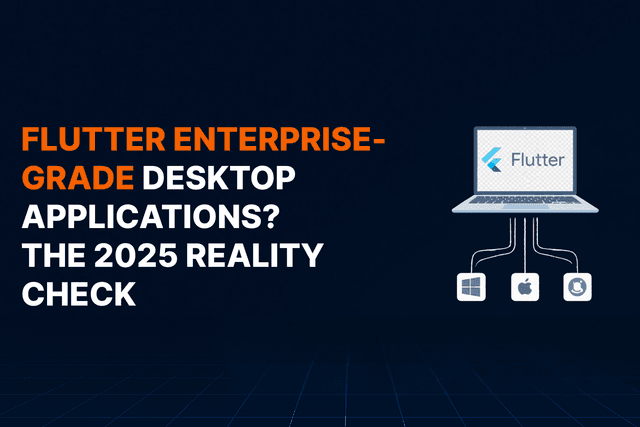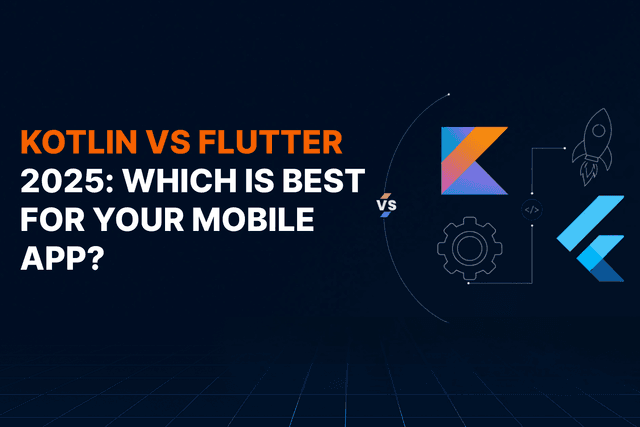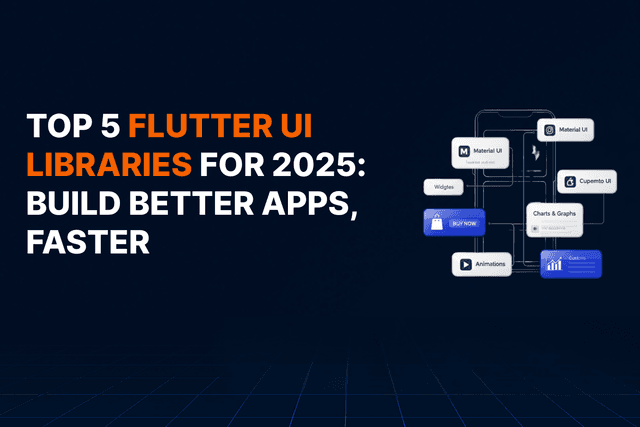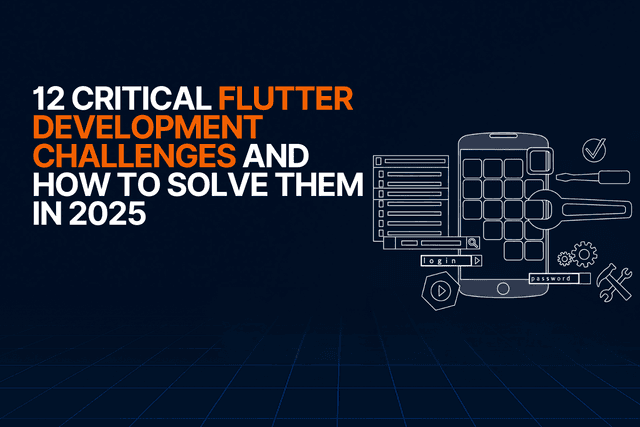How to Choose the Right Flutter App Development Services Partner
A practical guide for CTOs and founders to vet Flutter development partners. Compare costs, evaluate portfolios, and avoid common hiring mistakes.
The landscape of mobile and web application development has been fundamentally reshaped by cross-platform app development frameworks. Among these, Flutter has ascended to a position of clear market dominance. Since its launch, Flutter has become the desired solution for businesses seeking to streamline the development process, minimize costs, and efficiently deliver high-quality user experiences across multiple platforms. Choosing the wrong partner when you decide to hire flutter app development services can cost you six months and half your runway. The framework itself is brilliant, but execution depends entirely on who's writing the code. This guide from Voxturrlabs walks CTOs, founders, and product managers through a systematic vetting process on How to Choose Flutter Development Services/Partners to find a Flutter team that ships quality apps on time and within budget.
1.1. Flutter’s Dominance and the Vetting Challenge
The data confirms Flutter's strategic importance. As of 2024, Flutter is utilized by over 42% of developers worldwide, solidifying its status as the most popular cross-platform development framework globally. This popularity is driven by continuous optimization, which has recently demonstrated performance enhancements such as a 20% improvement in rendering speed and a 15% reduction in app size. This data makes it clear Why Flutter is the Go-To Choice for Start-ups and large enterprises alike. Recent surveys indicate that 38% of large companies have adopted Flutter for their mobile and web app development needs, a substantial increase suggesting its readiness for enterprise-grade deployment. This pervasive adoption underscores a critical shift: the focus is no longer merely on if a framework can deliver an application, but how well it can deliver a highly scalable, architecturally sound solution through expert Flutter App Development. This popularity, however, presents a core challenge for clients: the market is crowded. The proliferation of development agencies claiming Flutter expertise makes it difficult to distinguish between firms capable of building a simple prototype and those possessing the necessary architectural maturity to handle complex, enterprise-scale projects with demanding performance requirements. A rigorous, phased vetting process is essential to secure a truly skilled and reliable development partner.
II. Phase 1: Strategic Preparation - Establishing the Project Foundation
Before initiating contact with any potential development partner, clients must undertake a thorough internal preparation phase. This strategic homework is necessary to mitigate ambiguity, set clear contractual expectations, and pre-mitigate significant project risks, such as scope creep and budget overruns.
2.1. Defining Clarity: The Minimum Viable Product (MVP) Blueprint
The foundation of a successful engagement lies in the rigorous definition of the Minimum Viable Product (MVP). The MVP is often misunderstood as a half-finished product; instead, it must be viewed as a strategic, focused release designed to test market viability and gather essential early user feedback. A robust MVP blueprint focuses intensely on simplicity and core functionality, ensuring the initial launch delivers unique solutions that address real user problems. Development teams must prioritize the non-negotiable feature set, guaranteeing that the product, though minimal in scope, maintains a quality user experience that retains engagement and secures valuable feedback for future iterations. This rigorous, upfront scope definition serves as the client’s primary contractual defense against the inherent budget and scope risks introduced by the flexibility of the Agile methodology. While Agile inherently assumes continuous change, which can lead to budget increases or uncontrolled scope expansion (scope creep), a documented MVP scope allows the Flutter App Development process to utilize strategic risk mitigation methods. By establishing a clear baseline, the project transforms the inherent volatility of Agile into a controlled, phased expansion, where subsequent iterations are built strategically upon a stable, market-validated MVP.
2.2. Setting the Financial and Time Guardrails
You as a Clients must enter negotiations equipped with realistic expectations regarding development time and budget, which are inextricably linked to the project's functional and technical complexity. Understanding industry benchmarks helps clients assess whether initial quotes are realistic or dangerously low when considering the Flutter App Development Cost in 2025. The required duration and investment escalate significantly with complexity. The following table provides industry benchmarks for typical Flutter app cost:
|
App Type |
Target Scope (Focus on MVP) |
Estimated Time |
Estimated Cost (USD) |
|
Basic MVP App |
Essential features, simple design, minimal backend |
2–3 months |
$10,000 – $20,000 |
|
B2C eCommerce App |
Medium complexity, secure transactions, user profiles |
4–6 months |
$25,000 – $60,000 |
|
Enterprise SaaS App |
Complex integrations, custom data layers, scalable architecture |
6–9 months |
$60,000 – $150,000 |
|
Super App / On-Demand App |
High concurrency, complex location/real-time services |
9–12+ months |
$150,000 – $300,000+ |
Export to Sheets
For example, an Enterprise SaaS application requires significantly more time (6–9 months) and investment ($60,000 – $150,000 USD) than a Basic MVP app (2–3 months, $10,000 – $20,000 USD). When working with an Agile partner, mitigating financial risk is crucial. While Agile development is flexible, it must be managed proactively to prevent expenses from overcoming the initial budget. Reputable firms employ strategies like Lean Development, where the team estimates work module-by-module, or Rolling Wave Planning, where estimations are provided only when requirements are absolutely clear. These methods ensure financial predictability and accuracy within a flexible development structure.
2.3. Pre-Mapping Technical Roadblocks
Your Partner must meticulously identify and communicate all external technical dependencies and complex integrations upfront. These elements often require specialized solutions that exceed the capabilities of standard Flutter packages, acting as early indicators of whether a vendor possesses senior-level, cross-platform expertise. Complex integrations, such as payment APIs, highly specialized hardware access (e.g., custom sensors or file systems), or advanced capabilities like Artificial Intelligence (AI) and Machine Learning (ML), often cannot be solved purely with standard Dart code. For example, integrating specific AI/ML libraries like TensorFlow Lite or Core ML, or accessing specialized device features, demands a bridge to native code. This is the crux of the Platform Channel challenge. Platform Channels are the mechanism Flutter uses to communicate between the Dart codebase and platform-specific native code (Swift/Objective-C for iOS, Java/Kotlin for Android). If a project requires integrating features like ARKit, Core NFC, or proprietary payment gateways, the vendor must demonstrate specific experience not just in Flutter, but in writing secure, performant native code linked via these Platform Channels. The requirement for this native bridging capability serves as a crucial early filter for assessing the technical depth of the prospective partner.
III. Phase 2: Technical Vetting—Assessing Core Competence and Quality
This phase involves penetrating the vendor’s sales pitch to scrutinize their foundational technical competence, architectural philosophy, and track record in delivering high-performance, platform-adaptive applications.
3.1. Deep Expertise in Dart and Advanced Flutter Concepts
A highly skilled Flutter partner must demonstrate mastery of advanced concepts, particularly those related to performance optimization and application architecture. The focus should be on how they prevent resource waste and ensure a smooth user experience. During the technical assessment, the partner should detail their approach to maintaining performance, specifically addressing how they minimize widget rebuilds. A key indicator of a mature team is the consistent use of const constructors, which create immutable widgets that can be efficiently reused by the framework, significantly boosting performance. They should also articulate methods for efficient resource management, such as optimized image loading and the use of the Flutter DevTools for performance profiling and debugging. Furthermore, a critical test of senior-level capability involves the handling of heavy, non-UI-blocking tasks. Dart achieves parallel execution through Isolates. A partner unfamiliar with or avoiding the use of isolates for computationally intensive operations is likely to propose solutions that execute on the main thread, resulting in "jank"—the noticeable dropping of frames that degrades the user experience. Finally, the firm’s commitment to quality is revealed by its testing philosophy. A professional team employs a comprehensive testing strategy that includes unit tests (for business logic), widget tests (for individual UI components), and integration tests (for full app flows). They should utilize industry-standard tools like the Mockito package for creating mock objects during testing and the Flutter_test package for writing various test types.
3.2. State Management Philosophy: The Architecture Test
The choice of State Management (SM) library is arguably the clearest indicator of a development partner’s architectural maturity and commitment to long-term viability. The SM approach dictates how the application’s data logic is separated from the UI, directly affecting scalability and maintainability. A poor SM choice in a complex application leads directly to technical debt, which exponentially increases the time and cost of bug fixes and future feature implementations. For serious, long-term applications, especially those categorized as Enterprise SaaS or Super Apps, the partnership should center around architecturally robust solutions: BLoC (Business Logic Component), favored for large-scale enterprise applications for enforcing clean separation of concerns and high testability, and Riverpod, which offers increased flexibility and type safety, promoting a modular architecture suitable for scalable, long-term maintainability. The approach to State Management acts as a direct proxy for the firm’s long-term architectural philosophy and its tolerance for technical debt. If a vendor proposes a highly simplistic SM solution for a highly complex project, it signals a decision to prioritize short-term development speed over long-term stability and scalability, guaranteeing higher maintenance costs for the client in the future. Investing in a partner who understands and implements BLoC or Riverpod for complexity yields the best long-term dividends.
3.3. Portfolio Review: Demonstrating True Cross-Platform Mastery
When reviewing a development partner’s portfolio, the evaluation must extend beyond mere visual aesthetics. Quality must be measurable in performance metrics and platform adaptability. Clients should demand evidence of: Performance (fast load times, smooth 60 FPS animations), and Complexity (examples of custom data layers, large dataset handling). Crucially, the assessment must determine if the application truly achieves a "native feel" on both platforms, avoiding what is often referred to as the "uncanny valley" of cross-platform design. Developers who heavily customize Flutter apps to look uniformly consistent across iOS and Android often produce a "Frankenstein UI" that feels "off" or "alien" to native platform users, leading to confusion and poor user retention. A high-competency partner actively adapts platform-specific behaviors, utilizing platform checks to render the correct widget set, ensuring seamless user experiences that adhere to the distinct design paradigms of each operating system. Failure to implement these platform adaptations is a structural shortcoming that can lead directly to negative App Store visibility and user reviews, confirming that the cost of poor platform UX ultimately outweighs the savings derived from a single codebase.
IV. Phase 3: Process and Partnership—Collaboration and Security
The final phase of vetting focuses on the operational transparency, financial integrity, and legal protections that govern the long-term relationship. When looking to hire flutter app development services, this phase is critical.
4.1. Embracing the Agile Advantage for Flutter Development
Agile methodology is highly synergistic with Flutter App Development. Agile emphasizes breaking down the process into small, iterative sprints focused on continuous improvement and customer feedback. Flutter’s Hot Reload feature significantly accelerates this cycle, allowing developers to instantly transform customer feedback into tangible UI changes, enhancing velocity and customer focus. However, the client must demand verified transparency. The partner must provide full, immediate access to their project tracking tools, most commonly Jira Software. Demanding Jira access is an essential non-negotiable for monitoring value delivery. Jira offers customizable workflows, robust issue tracking, advanced reporting, and scalability. Client access allows stakeholders to maintain complete visibility into the project's real-time progress, track sprint adherence, identify bottlenecks, and ensure resources are being deployed efficiently. Denying client access effectively creates a "black box" environment common in low-transparency outsourcing, directly undermining the principles of collaboration that define successful Agile practice.
4.2. Cost vs. Value: Protecting Your Investment
A common pitfall in vendor selection is the reflexive choice of the lowest bid. This decision carries a high financial risk, as initial savings are almost always negated by increased long-term costs due to systemic quality compromises and hidden charges. Low-bid vendors typically cut costs on essential, non-visible items, resulting in critical limitations such as poor support, technical debt accumulation, and lack of scalability. When looking for a reputable Flutter development company India or anywhere globally, price must be assessed against value, not just as a raw number. These initial cost-cutting measures necessitate unforeseen expenses later in the project lifecycle, including additional fees for essential integrations, customizations, and workarounds to compensate for inherent software limitations. The mandate, therefore, is to demand transparent, itemized quotes. A development quote is an official contractual document that details the estimates relating to cost, scope, and timing. The quote must provide a detailed breakdown, including: The specific scope of work, clearly mapped to the Phase 1 MVP features; The technologies employed (e.g., specified State Management library, database schema); The estimated hours and resources allocated per feature or module. This level of detail ensures the client is evaluating cost relative to verifiable value, not merely an unspecific lump sum price.
The risks associated with prioritizing the lowest Flutter app cost are clearly outlined in the risk assessment:
|
Area of Evaluation |
Low-Bid Vendor Risk |
Value-Based Partner Benefit |
|
Quote Clarity |
Vague lump sum; resulting in hidden fees and unexpected charges. |
Detailed, itemized breakdown of scope, technology, and estimated hours. |
|
Code Quality/Architecture |
Accumulation of technical debt; reliance on suboptimal state management. |
Clean, modular code; robust use of BLoC or Riverpod for scalability. |
|
Post-Launch Viability |
Minimal or non-existent support; failure to provide critical security updates. |
Dedicated maintenance contract covering OS and security updates. |
|
Project Visibility |
Limited, opaque updates; client denied access to tracking tools (Jira). |
Transparent Agile process; full client access to project management platform. |
Export to Sheets
4.3. Legal Safeguards: Non-Negotiable IP Ownership
Protecting Intellectual Property (IP) and ensuring complete source code ownership transfer is a legal imperative. This must be explicitly addressed and secured within the development contract. The contract must contain clear clauses outlining that the IP rights to the app and all associated materials (e.g., source code, design assets, documentation) created during the development process belong exclusively to the client. Furthermore, the contractual agreement must specify the method and timing of source code transfer and prohibit the developer from using the client's ideas or code for their own future purposes without explicit permission. Ensuring this full transfer of ownership provides necessary legal control over the application's future development and commercialization.
4.4. Post-Launch Viability: The Maintenance Guarantee
A newly launched application is not a static asset; without a robust maintenance and support plan, it possesses a guaranteed obsolescence date tied to the next major operating system (OS) update cycle. A competent development partner must offer dedicated post-launch services to ensure the app’s continued viability, security, and competitiveness. As Google and Apple frequently roll out new OS versions, continuous compatibility updates are critical. The maintenance plan must address key components: OS Compatibility and APIs (routine updates for latest OS versions); Security and Compliance (regular security patches); Performance Monitoring (continuous monitoring to identify bottlenecks); and UI/UX and Feature Enhancement (addressing user feedback and keeping the app competitive).
Conclusion:
Choosing the right Flutter App Development partner takes time, but the investment pays off in faster time-to-market, fewer post-launch bugs, and long-term maintainability. At Voxturrlabs, we have shipped Flutter apps for start-ups and enterprises across fintech, health, e-commerce, and logistics. Our team combines deep Flutter expertise with transparent communication and post-launch support, helping you navigate the complexities of cross-platform app development to build a high-quality, scalable product.

Gaurav Lakhani is the founder and CEO of Voxturrlabs. With a proven track record of conceptualizing and architecting 100+ user-centric and scalable solutions for startups and enterprises, he brings a deep understanding of both technical and user experience aspects. Gaurav's ability to build enterprise-grade technology solutions has garnered the trust of over 30 Fortune 500 companies, including Siemens, 3M, P&G, and Hershey's. Gaurav is an early adopter of new technology, a passionate technology enthusiast, and an investor in AI and IoT startups.

Ready for a Next-Level of Enterprise Growth?
Let's discuss your requirements
You May Also Like

App Development
Can Flutter Build Enterprise-Grade Desktop Applications? The 2025 Reality Check
An honest 2025 reality check on when Flutter desktop actually works for enterprise apps, where it struggles, and how CTOs should decide.
25 min read

App Development
App Development Charges in 2025
Discover the real App Development Charges in 2025. Learn stage-by-stage costs, tips to save, and how VoxturrLabs helps you build smarter. Book a free consult now!
19 min read

App Development
Flutter App Development Cost in 2025: Complete Breakdown
2025 guide to Flutter app development cost. See ranges from $10k to $200k+, key cost drivers, complexity tiers, region wise rates, and a simple estimate cost breakdown,
7 min read

App Development
Kotlin vs Flutter 2025: Which Is Best for Your Mobile App?
A practical comparison guide for product leaders, founders, and mobile teams choosing their cross-platform stack
16 min read

App Development
Best Backend for Flutter: Which Cloud Services Actually Work in 2025?
Firebase vs Supabase vs AWS Amplify: A practical guide to choosing the right backend for your Flutter app without the hype or surprises.
9 min read

App Development
Why Flutter Web App Development?
One codebase for mobile and web sounds perfect. But Flutter Web isn't right for every project. Here's when it works, when it doesn't, and how to choose wisely.
10 min read

App Development
Top 5 Flutter UI Libraries for 2025: Build Better Apps, Faster
Your Flutter UI Toolkit Just Got a Major Upgrade
9 min read

App Development
12 Critical Flutter Development Challenges and How to Solve Them in 2025
A Guide to Building Scalable, Performant Flutter Apps That Don't Accumulate Technical Debt
21 min read
Start a conversation by filling the form
Once you let us know your requirement, our technical expert will schedule a call and discuss your idea in detail post sign of an NDA.